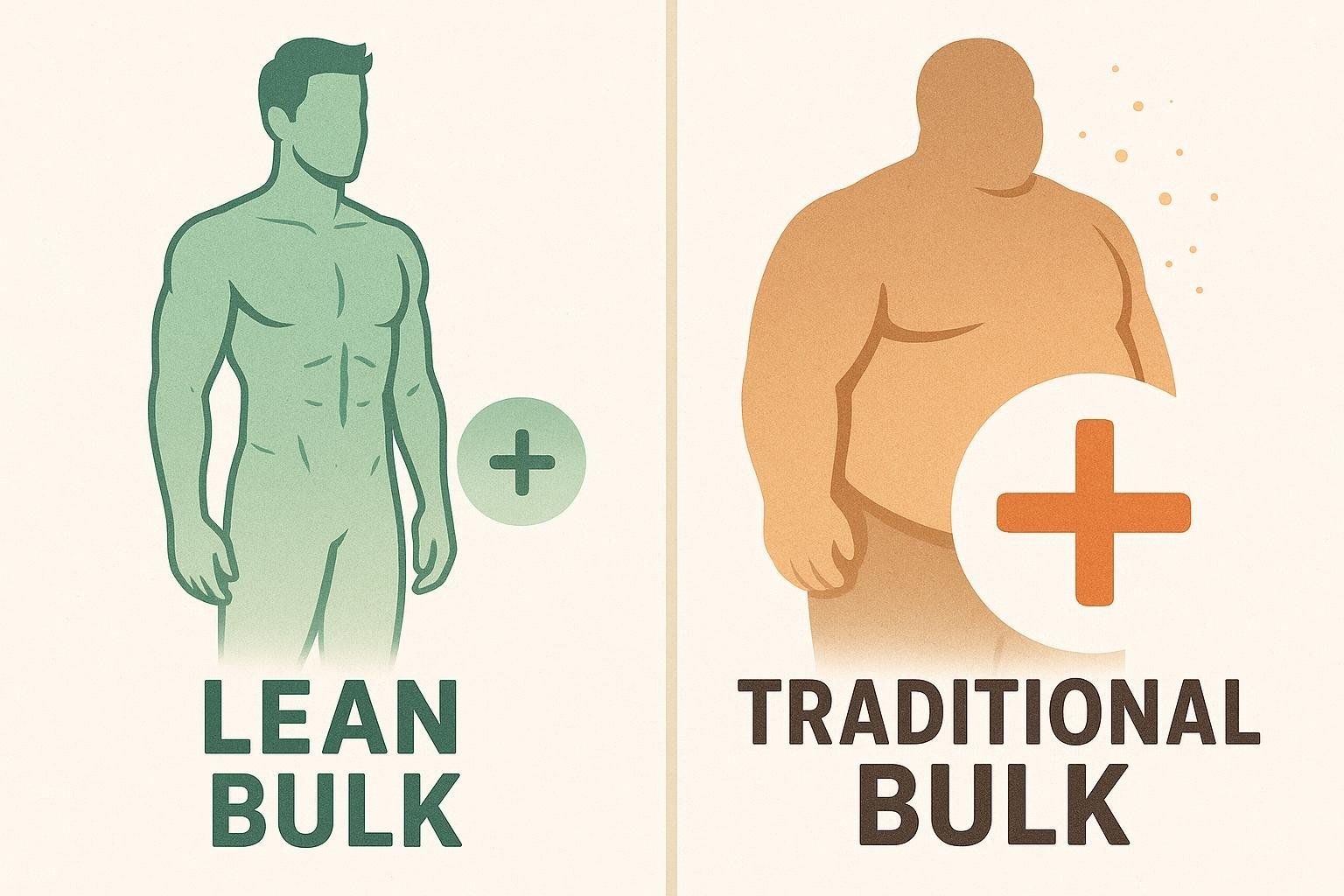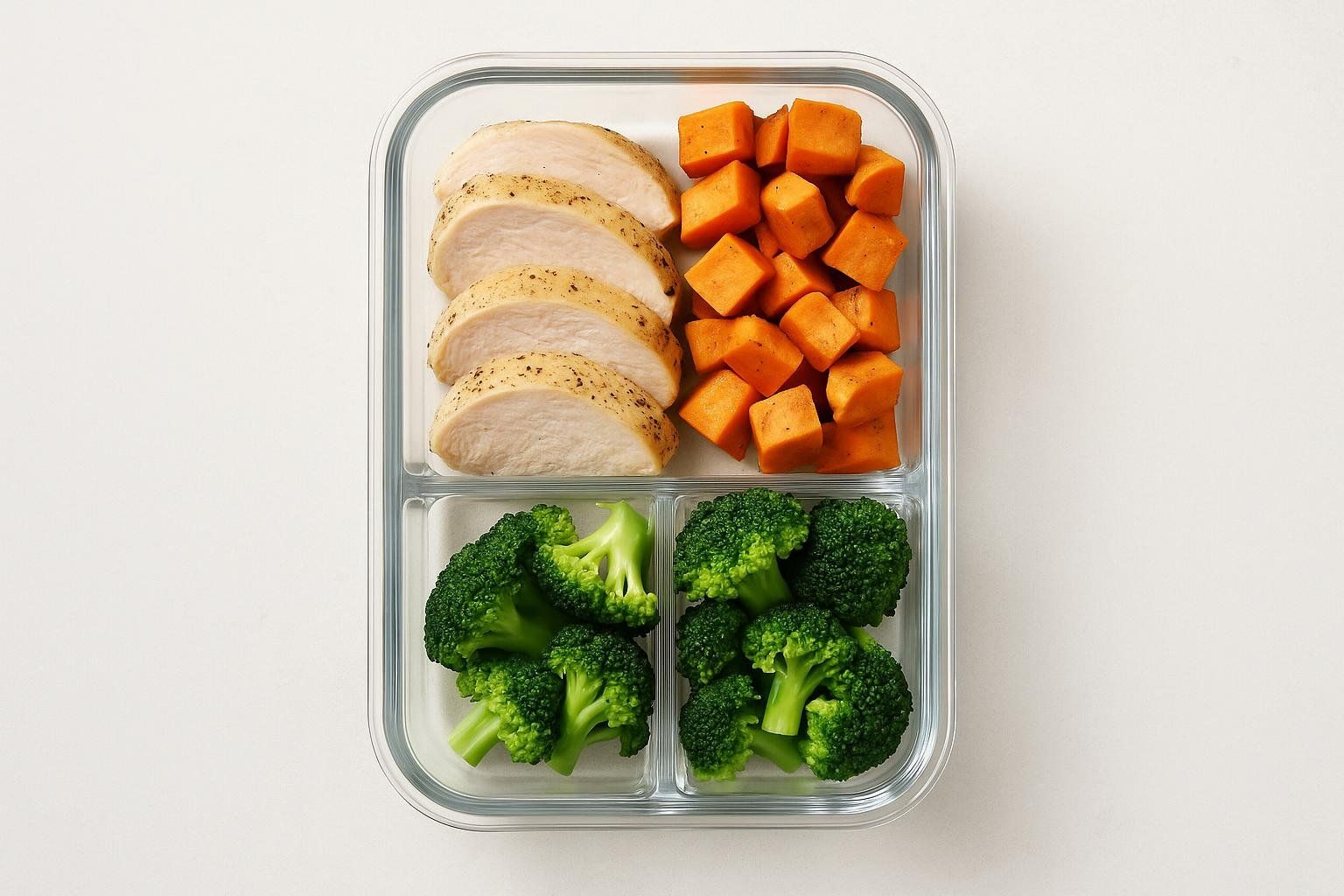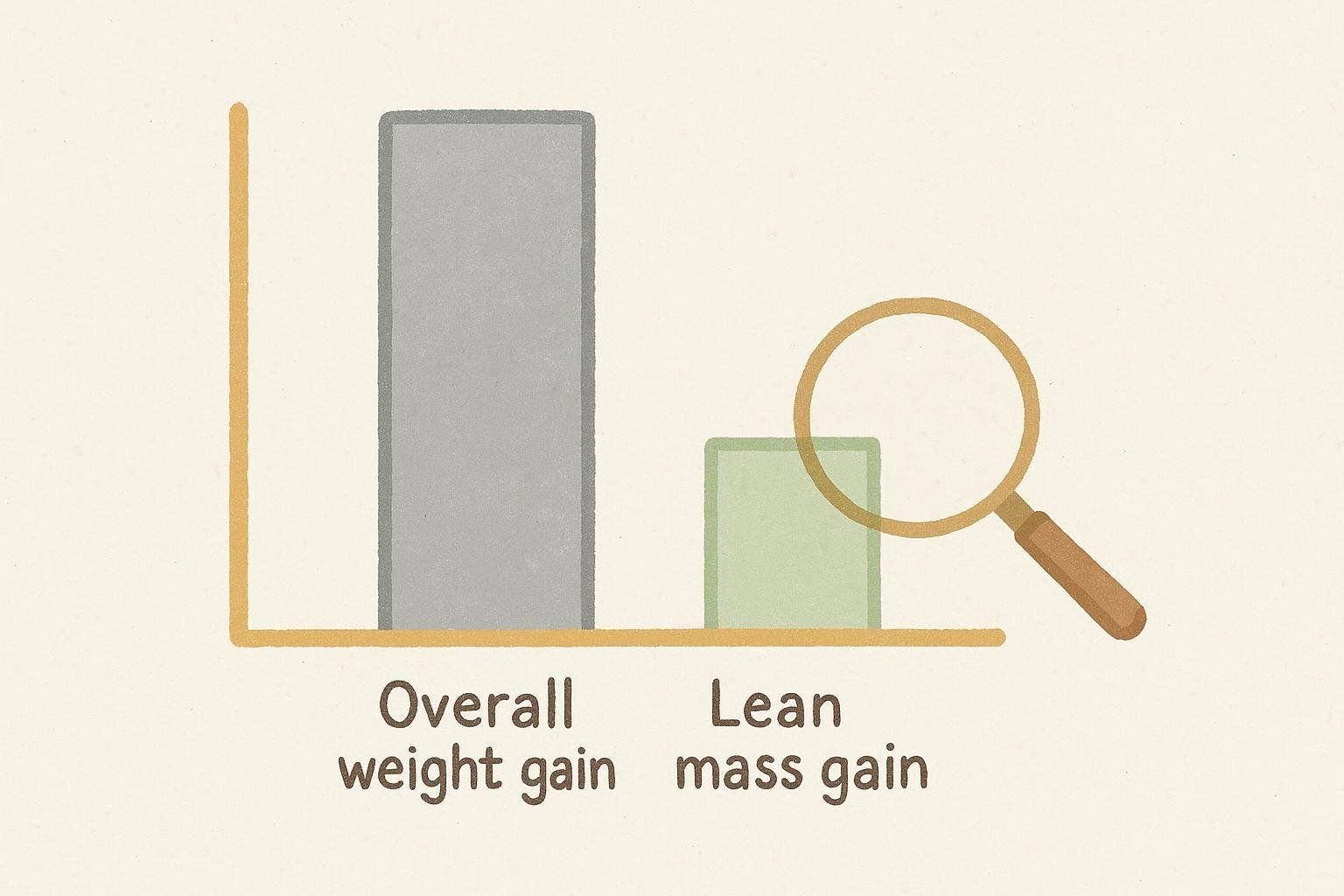How to Lean Bulk Effectively: A Step-by-Step Guide

Lean Bulk Essentials: DEXA-Backed Strategies for Building Muscle—Not Fat
Physically, the differences between lean muscle and bulk are pretty apparent. Lean muscle is all about that shredded, sculpted look, while muscle bulk is more about sheer size and power. It's like the difference between a sleek race car and a hulking tank.
Lean bulking sounds simple on paper—eat a little more, lift a little heavier, and watch the scale climb. In practice, most lifters discover two harsh truths:
- A “see-food diet” adds fat faster than it adds muscle.
- The bathroom scale can’t tell which is which.

That’s where BodySpec’s DEXA scans come in. A 6-minute scan reveals your precise fat mass, lean mass, visceral fat, and bone density. When you combine those data points with a smart nutrition and training plan, you get the ultimate formula for gaining muscle while keeping fat gain to a bare minimum.
This guide moves beyond typical internet advice. It offers DEXA-rooted strategies, actionable macro-calculation steps, and practical meal templates built around three real-world lifestyles. Whether you’re a busy college student, time-crunched professional, or coach looking to level-up client results, you’ll walk away with an evidence-based plan.
TL;DR – Your Lean Bulk Checklist
- Get a baseline DEXA scan to know starting fat mass, lean mass, and visceral fat.
- Create a small calorie surplus (≈5–15 % above maintenance). Research shows larger surpluses mainly increase fat gain (Slater et al., 2019).
- Hit daily macros – 1.6–2.2 g protein/kg bodyweight (ISSN Position Stand), balanced carbs, and fats that land between 20–30 % of total calories.
- Train for hypertrophy – compound lifts + progressive overload, 10–20 hard sets per muscle each week.
- Limit cardio to 2–3 LISS sessions or 1–2 HIIT finishers so recovery stays on track.
- Sleep 7–9 hours, manage stress, and schedule two rest days weekly.
- Re-scan every 4–6 weeks and tweak surplus or training based on DEXA data.
What Exactly Is a “Lean Bulk”?

A lean bulk is a muscle-building phase where you deliberately stay in a modest calorie surplus—just enough to fuel muscle protein synthesis (MPS) without warehousing excess body fat. That usually translates to gaining 0.25–0.75 lb (0.1–0.35 kg) per week for most lifters.
Lean Bulk vs. Traditional Bulk
| Lean Bulk | “Dirty”/Traditional Bulk | |
|---|---|---|
| Calorie Surplus | 5–15 % | 20–40 %+ |
| Weekly Weight Gain | ≤ 0.75 lb | 1–2 lb |
| Fat Gain | Minimal | Significant |
| Primary Tracking Tool | DEXA scan | Bathroom scale |

Evidence shows larger surpluses (>500 kcal) increase fat mass more than they accelerate muscle growth (Slater et al., 2019).
STEP 1 – Establish Your Baseline with a DEXA Scan
While standard formulas offer a helpful starting point for calorie and macro targets, a baseline BodySpec scan provides the precise data needed to tailor these numbers to your unique physiology—moving beyond generic calculator estimates.
Plan to re-scan every 4–6 weeks and compare changes in lean mass vs. fat mass. Based on BodySpec’s analysis of thousands of client scans:
- If more than ≈60 % of the new weight you gain is fat, tighten the surplus toward the lower end (≈5 %).
- If ≈80 % or more of the new weight is lean tissue, you’re on track—maintain your current plan.
STEP 2 – Calculate Your Daily Macros
- Find Maintenance Calories. Bodyweight (lb) × 14–16 (≈ 14 for less-active, 16 for very active).
- Add a Surplus. Choose a surplus between 5 % and 15 %.
- Set Protein. Aim for 0.73–1 g per lb bodyweight (1.6–2.2 g/kg); 1 g/lb is a convenient target within this range.
- Set Fat. Allocate 20–30 % of total daily calories to dietary fat—typically about 0.3–0.5 g per lb of bodyweight. Adhering to this 20–30 % range supports hormone health and nutrient absorption.
- Fill the rest with carbs.
Macro Calculator Example (180 lb Intermediate)
| Step | Formula | Example | Result |
|---|---|---|---|
| Maintenance kcal | BW × 15 | 180 × 15 | 2,700 kcal |
| Target Calories | Maintenance × 1.10 (10 % surplus) | 2,700 × 1.10 | 2,970 kcal |
| Protein | BW × 1.0 | 180 × 1 | 180 g (720 kcal) |
| Fat | Target × 0.25 ÷ 9 | 2,970 × 0.25 ÷ 9 | 83 g (747 kcal) |
| Carbs | (Target – Protein – Fat) ÷ 4 | (2,970 – 720 – 747) ÷ 4 | 376 g |
Need more guidance? Read Ultimate Guide to Tracking Macros.
STEP 3 – Build Your Plate: Meal Templates for 3 Lifestyles
Macro estimates below are in grams (P = protein, C = carbohydrates, F = fat).
1. The College Schedule (John, 22)
| Time | Meal | Example | Macros (g) |
|---|---|---|---|
| 8 am | Grab-&-Go | Greek yogurt, banana, whey shake | 40 P / 60 C / 5 F |
| 12 pm | Campus Lunch | Burrito bowl (double chicken, rice, beans) | 55 P / 80 C / 15 F |
| 4 pm | Snack | Trail mix, chocolate milk | 20 P / 45 C / 15 F |
| 7 pm | Dorm Dinner | Frozen salmon, microwavable quinoa, mixed veggies | 45 P / 70 C / 20 F |
| 10 pm | Pre-bed | Cottage cheese, honey | 25 P / 15 C / 5 F |

2. The Busy Exec (Aisha, 29) — Sample Work-Day Menu
| Time | Meal | Example | Macros (g) |
|---|---|---|---|
| 6 am | Pre-workout | Banana + whey | 25 P / 30 C / 2 F |
| 8 am | Post-workout Smoothie | Whey, oat milk, berries, almond butter | 45 P / 60 C / 15 F |
| 12 pm | Desk Lunch | Sheet-pan chicken, sweet potato, broccoli | 45 P / 50 C / 10 F |
| 3 pm | Snack | Greek yogurt, almonds | 25 P / 20 C / 15 F |
| 7 pm | Client Dinner | Salmon, quinoa, asparagus | 50 P / 60 C / 20 F |

3. The Personal Trainer (Marcus, 38) — On-the-Go Template
| Time | Meal | Example | Macros (g) |
|---|---|---|---|
| 5 am | Overnight Oats | Oats, whey, chia seeds, blueberries | 40 P / 65 C / 10 F |
| 9 am | Smoothie Bar | 16 oz whey-fruit smoothie | 35 P / 55 C / 5 F |
| 12 pm | Lunchbox | Turkey-avocado wrap, apple | 45 P / 45 C / 18 F |
| 3 pm | Gap Snack | Beef jerky, rice cakes | 25 P / 30 C / 5 F |
| 7 pm | Family Dinner | Lean beef stir-fry, jasmine rice, veggies | 50 P / 70 C / 15 F |
For more recipes, visit Crafting Your Lean Bulk Meal Plan.
STEP 4 – Train Smart for Hypertrophy
- Lift 4–5 days/week. Focus on compound movements (squat, bench, deadlift, pull-ups, overhead press).
- Progressive Overload. Add 5 lb, an extra rep, or another set each week.
- Volume Guidelines. Aim for 10–20 hard sets per muscle weekly.
- Cardio Done Right. Two 30-minute LISS sessions keep your heart fit without impairing gains (Lundberg et al., 2022).
Need a program? See Ultimate Muscle Mass Guide.
STEP 5 – Recover, Re-scan, Repeat

- Sleep: One night of total sleep deprivation can reduce muscle protein synthesis by ~18 % (Lamon et al., 2021).
- Rest days: are growth days—schedule at least two per week.
- Re-scan every 4–6 weeks: If a scan shows >60 % of new weight as fat, BodySpec coaches recommend trimming your surplus to around 5 %. If >80 % is lean, maintain your current surplus to keep the momentum.
Track each DEXA result in a spreadsheet or app to visualize your lean-mass trajectory over time.
Common Pitfalls & How DEXA Saves the Day
| Mistake | How It Shows Up on DEXA | Fix |
|---|---|---|
| Surplus too large | Sharp uptick in fat mass; visceral fat increases | Cut surplus to 5 %, add a HIIT session |
| Not enough protein | Body weight climbs, lean mass plateaus | Increase protein to 1 g/lb within range |
| Inadequate sleep quality | Lean mass stalls despite calorie surplus | Prioritize 7–9 hrs; set a blue-light curfew |

More troubleshooting tips: Breaking Through Plateaus.
Ready to Put Numbers Behind Your Gains?
A tape measure can’t see visceral fat, and the mirror lies on bad-lighting days. A BodySpec DEXA scan costs less than a new pair of lifting shoes and shows exactly what your bulk is building.
- Book a baseline scan today.
- Follow the checklist above for 6 weeks.
- Re-scan and adjust—science, not guesswork.
Find a DEXA scan near you and start your lean bulk the data-driven way.


